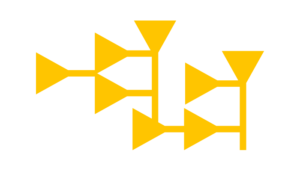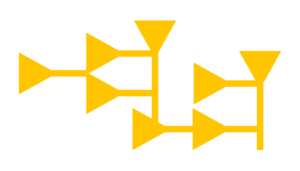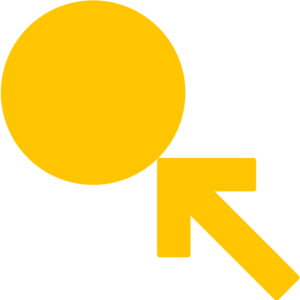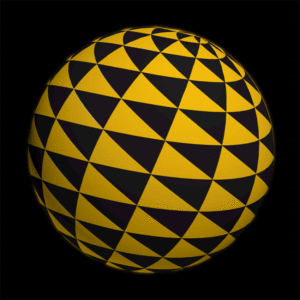In the previous essay, when describing the Pre-Letter "B", I made a remark that letters as well as sounds can be attributed specific gender. This seemingly unusual statement will be illustrated by the Pre-Letters: "C", "K" and "Q". They were created from symbolic matter associated with the feminine aspect. This symbolic matter is the moon.
Writing about "C", "K" and "Q", I begin my considerations, in the same manner as George Lucas did in his Star Wars, but slightly modifying the text, that is, "Once upon a time in our galaxy ...".
In our galaxy, on Earth, I believe that no later than about 12,000 years ago, a brilliant writing system was invented, on which modern speech is based.
The pre-letter "C" is the first of those I describe that belongs to the system mentioned above, created from being inspired by Celestial Bodies. The previous two "A" and "B", which were mentioned in previous essays, were based on the inspiration that was the man himself. They will also appear in the next essays, the pre-patterns of those Pre-Letters, were the animal world itself.
In this way, the space of language, as well as imagination, knowledge and faith, universal for people of the Great Culture, consisted of the combination of these three worlds, which could be, in fact, considered one inseparable whole. Man, therefore, perceived himself as a being connected to the stars as well as to the animal world. You can conceptualize this connection as mutual interference. Due to this interference the Celestial Bodies had - in a symbolic sense - human and animal traits for a man of Great Culture. Similarly, like the Celestial Bodies, humans and animals were remaining in the relation of mutual permeating with the cosmos and with each other.
In those days and with the then exceptional sensitivity to nature, the Pre-Letter system was simple and somehow natural for man and as such could become universal for people scattered throughout a vast territory. Today, so that we can fully understand it, we would have to discard many of the common patterns that have accompanied us since the new order of narrative in which we find ourselves now, was introduced. This narrative, created over two thousand years ago, describes our "I" to us in a completely different way than in the times of Great Culture. What's more – the sense of our "I", and its being, was erroneusly reinterpreted by means of the redefined concept of beginning and end. And the concept of beginning and end, since then, has the hallmarks of what is ultimately accomplished - while earlier the beginning was conceived as a continuation, and the end was also considered a beginning.
My initial intention was to describe each of Pre-Letters : "C", "K" and "Q" separately, yet I found that this procedure would make it significantly harder to understand how much emotional and symbolic tension they contain. Therefore, I decided that that this essay would be longer and would include several sounds, which I will try to describe in a sketchy way, to be able to present them in more extensive manner in the future.
A few words about the Moon.
The moon is a celestial body that can be observed without specialized instruments. Because it does not rotate around its axis, it is constantly facing the earth with the same hemisphere. In this hemisphere, depending on the angle of the sun's rays, we can see reflected sunlight - while the other part of the moon remain in the shade.
The exceptions are its two phases: the full moon when the entire face of the Moon is illuminated by the Sun's rays and the New Moon when the moon's surface is not being illuminated by sunlight because it is positioned in relation to the sun with its other, invisible, hemisphere.
The moon affects both our well-being and the rhythm of nature, which was once closer to human than it is today. Nowadays we seem not to discern it at all, and certainly not in the way we used to do.
For a man living in the age of the Great Culture, the observation of the moon and linking it to the ebbs and flows could have been a contribution to the development of thought as such. Certainly, over time, this thought was elaborated and systematized.
As we know, ancient calendars were based on data obtained from observations of this celestial body (similarly to data obtained from observations of the sun).
Admittedly, the moon played a significant role in the days of Great Culture, which I will write about in more detail in separate essays. Due to its likely contribution to the development of ability of associating cause and effect, calculation and imagination – it deserves to be respected. This respect has been manifested in many concepts related to geometry.
Woman and the moon.
The symbolic relationship between a woman and the moon is very well known in culture. Why did the designer of Pre-Letters associate this celestial body with the fair sex? He probably did so because a woman is different / opposing a man. To perceive this difference, one should focus not so much on some general features of humanity that connect two sexes, but directly on their primary features and their functions. They can be called as follows: the function of fertilization and the function of being fertilized. This "causative aspect" and "aspect of being susceptible to" can be compared with those of heavenly bodies - the sun and the moon.
The man was therefore identified with the sun. This comparison of the "male element" to the sun had its justification in the fact that: the sun emits energy in the form of light, this emission is continuous and like the constantly shining sun, a man, until the end of his life, can fertilize a woman with his seed every day.
A woman, unlike a man, can be fertilized only at a certain moment in her cycle and up to a certain age. Thus, woman's menstrual cycle, as well as the periods of her life, can be compared to the phases of the moon.
As in the case of the moon, we can distinguish individual phases here, namely: new moon, waxing crescent moon, full moon and waning crescent moon, in an analogous way similar phases can be distinguished in the woman's cycle, namely: menstrual, follicular, ovulatory and luteal phase.
Another connection between the moon and the female sphere is related to the fact that women usually menstruate around the new moon, and the fertile period occurs around the full moon. In addition, the moon, which looks like a large dead solid resembling a round stone, becomes enlivened by the rays of the sun falling on it. And when it is provided with solar light to the greatest extent, that is fully, a woman has the greatest chance of becoming pregnant.
Nowadays, science "is throwing up its hands" wondering how to explain the transformation of dead matter into living matter in its vision of the creation of the world.
Didn't the man of Great Culture ask himself who he really is? I am strongly convinced that he felt being a part of the universe. If, however, he was open to the influence of its infinite dependencies and accepted them, he felt much more - than we are nowadays - able to comprehend them in reasonable way. I emphasize the term « reasonable » here, intentionally, because we don't feel being a part of nature anymore.
Thus if we pose a question whether did a dead moon identified with a woman as a mother symbolize the life of seemingly dead matter? - the answer could be only positive.
Let's remember that one of the hypotheses concerning the issue of the creation of the moon states that it is a fragment of the earth that has fallen away from it as a result of a cosmic collision – in which it participated. If one considers the moon as just a dead piece of land, could we say that its surface is idle until the rays of the sun fall on it?
Interestingly, these analogies of the properties of heavenly bodies corresponding to female and male aspects made both the sun and the moon an excellent symbolic material for the theory of several Pre-Letters as well as of speech itself.


The Pre-Letter "C" is the last phase of the moon before the arrival of the new moon phase.
We tend to perceive the Pre-Letter "C" as a thin strip of sunlight reflected from the moon's surface. In this phase, the moon reflects sunlight at an angle, while the rest of its surface remains in the shade. I recommend to consider the Pre-Letter "C" as a drawing made from the perspective of the angle with which the sun's rays are reflected from the moon.
The Pre- Letter "C" as death.
A thin strip of sun rays reflected from the moon's surface symbolizes the impending moment of death. In our consciousness, good or life has always been associated with light, and darkness or evil - respectively - with death. In the next phase, the new moon "perishes" in the darkness. And its next phase, when the sunlight begins to appear again on its surface, symbolizes the hope that it will soon shine again fully. In this way, the cyclical nature of the intervals of days and nights, months, seasons symbolizing periods of human life as well as consecutive years is associated with the moon. This rhythm covers the human life until his death.
But did a man of Great Culture understand death as we understand it today? Wasn't death, like the new moon, just a state before the moment of being born again in the cycle of man's rebirth after death? Rebirth, as nature indicates, which proceeds from infinity to infinity? Wasn't the theme of rebirth after death, just as it was preserved in the Eastern philosophy, also part of our intellectual tradition during the time of Great Culture? I think that this is how death was understood by a man of Great Culture, which is indicated by the very construction of Pre-Letters, which I will present extensively in the next essays.
The previous term 'cimierci' has been replaced by the modern term 'śmierć' (death).
I think that the change of the sound "K" and "C" to "S" has not been described as an ideological change. I think that this transformation of the sound was an expression of the influence of one overarching factor that affects all sounds as well as their "order" in words.
To let him remain mysterious for now - I call him Mr. X. As a hint I can say that X is well known nowadays and we talk a lot about him because he is a very important "person". Referring to him as "X" seems very appropriate in this context because this term usually describes a person who is not mentioned by name, but is known to mean a lot and be powerful. I assure you that "X" just means a lot and is powerful - it's a joke/ rebus, for those who would like to solve it. I am going to introduce You Mr. X after describing one of the next Pre - Letters.
"C" as a side or a fundament.
In my opinion Pre-Letter "C" was considered as the left side of the Moon, in our latitude, while in the Middle East and Egypt, for a man of Great Culture, it was considered more a fundament than a side. I will elaborate this idea in the next essays, because I find it very important.


Specifically:
The Pre -Letter "K" as a question of the nature of the space arrangement of the moon, earth and sun.
”K” is a very interesting symbol. It presents an issue that includes the question of whether the sun, moon and earth are located in a straight line structure or whether the sun's rays are reflected from the moon at right angles? Admittedly, in order to answer the question posed, it is necessary to calculate the value of this angle.
I suggest considering "K" as two elements - the left one as a straight line and the right one as a curved line forming a right angle.
These two elements are important, because depending on the arrangement of these three celestial bodies we can see the appropriate phases of the moon. The full moon can be seen when both the earth, the moon and the sun are "set" almost on a straight line. The moon in the other phases reflects the sun's light at an angle.
This observation of the earth, moon and sun system was formerly called triangulation (kątowanie/kantowanie). Description of triangulation understood as counting is mentioned in the text below and is very important because it indicates its relationship with the word "count" in many languages.
Kontować/Triangulation – formerly considered as counting.
If you go for a walk around the Kościuszko Mound in Krakow - in the "Salwator" district you will pass on the left a wooden chapel of St. Margaret and Judith. This place is called Gontyna. Gontyna is the transformed name « kącina » /koncina/. Contrary to what is claimed, in my opinion, this word was not transformed in the Romantic era or in the nineteenth century, but much earlier. I think that the reason for this change was the desire to discredit the value of the term « koncina ».
In the place where currently the Chapel of St. Margaret and Judith is located according to tradition previously was a place of pre-Christian worship. Probably many other temples were built in the same places where the God of Great Culture was worshiped during pagan times.
Returning to the word kącina /koncina / which later evolved into the word temple (świątynia) one should pose the question : what exactly was the object of worship in Kącina?
The object of worship was probably the angle. Angle / kąt/kont / - as we know - is a geometric concept. This suggests that the angle was not only worshiped but also calculated. When calculating the angle, people of Great Culture had to verify at what angle the rays of sunlight fall on the surface of the moon. These calculations, among others, provided knowledge about the time / date / calendar. Since it was the Angle (Kąt) which was an object of worship, also term "kenty" - before it underwent the change from "K" to "S" – contributed to the development of this concept.
It was probably then that "heart" (serce) was also referred to as "kerka", which also brings us closer to kinship with the celts whose descendants still use this terminology.
In the modern Polish language the sense of this archaic term 'kantowanie' has been reduced to describe an act of 'deception'.
Angulation (Kantowanie/kontowanie) has its counterparts in other languages - Spanish and Portuguese, where counting is designated by the word « contar ». Interestingly, it is similar in many other languages, e.g. English, French, Italian ...
It should be borne in mind that the word « counting » is a neologism, because in the past the term « kątować/kontować/kantować/ » as well as « rachować » instead of "count" was used.
Pre- Letters "C" and "K" as angulation (kątowanie/kontowanie)
When writing about kantowaniu/kontowaniu we should also mention the numbers. Although the issue of Pre-Numbers will be the subject of a separate essay, I think I will not reveal much if I say that the moon was associated with the number 6. An interesting fact is that the gravitational acceleration of the moon is 6 times smaller than the acceleration of the earth and its flattening (Ellipticity) is 0.0012.
The barycenter, or the common center of mass of the earth and the moon, is located about 60 Earth radii away from the Earth itself. The number 6, in turn, is associated with the polish term « kopa »- a unit of measure that was used, formerly, for referring to the number 60.
As you know, the number 60 was also significant for Sumerians and Babylonians, where they had the system in which the counting proceeded from 60 and up to 60.
For the Great Culture, therefore, our 60 - sixty - currently interpreted as a number was also considered a symbolic digit.
The "duodecimal" system on which our twenty four hours is based is an example of another interesting relation with the numerical symbol of the moon. We have day and night as if divided in half into two twelves. At noon (when the sun is at its highest point - it dominates) it is noon (twelve o'clock), while at midnight (the full moon is at its highest point) it is 24th.
This twenty four hours interval consists of four six-hour periods corresponding to the four phases of the moon. The hour itself is 60 minutes and the minute also consists of 60 seconds. The same is true for the months, of which there are twelve a year as well as full lunar cycles. Admittedly, this fact is of no surprise, since, as it should be emphasized, calendars were formerly lunar or lunar-solar.
Pre- Letters "C" and "K" as angulation (kątowanie/kontowanie)
When writing about kantowaniu/kontowaniu we should also mention the numbers. Although the issue of Pre-Numbers will be the subject of a separate essay, I think I will not reveal much if I say that the moon was associated with the number 6. An interesting fact is that the gravitational acceleration of the moon is 6 times smaller than the acceleration of the earth and its flattening (Ellipticity) is 0.0012.
The barycenter, or the common center of mass of the earth and the moon, is located about 60 Earth radii away from the Earth itself. The number 6, in turn, is associated with the polish term « kopa »- a unit of measure that was used, formerly, for referring to the number 60.
As you know, the number 60 was also significant for Sumerians and Babylonians, where they had the system in which the counting proceeded from 60 and up to 60.
For the Great Culture, therefore, our 60 - sixty - currently interpreted as a number was also considered a symbolic digit.
The "duodecimal" system on which our twenty four hours is based is an example of another interesting relation with the numerical symbol of the moon. We have day and night as if divided in half into two twelves. At noon (when the sun is at its highest point - it dominates) it is noon (twelve o'clock), while at midnight (the full moon is at its highest point) it is 24th.
This twenty four hours interval consists of four six-hour periods corresponding to the four phases of the moon. The hour itself is 60 minutes and the minute also consists of 60 seconds. The same is true for the months, of which there are twelve a year as well as full lunar cycles. Admittedly, this fact is of no surprise, since, as it should be emphasized, calendars were formerly lunar or lunar-solar.
Systems: duodecimal, pentadecimal, decimal, sexagesimal, or numbers as a result of observation of the universe
The duodecimal system is also traditionally called the pentadecimal system. The pentadecimal system, in turn, associates a 60-minute hour with the "apparent movement" of the sun above the horizon. It "moves" at an angular velocity of 15 degrees per hour. During the day, this "apparent movement" of the sun exceeds 360 degrees, which is equivalent to 6 x 60. So the rotation of the Earth 360 degrees around its axis caused the sun to "seemingly" move by 15 degrees per hour and for 24 hours to arrive again at its initial position on the horizon. In this "apparent movement" of the sun, one degree corresponded to four minutes. Observation and counting of the exact angle of the « movement » of the sun allowed people of the Great Culture to accurately determine the time, but not only.
I am strongly convinced that most of us are not aware of the fact that we live according to the rhythm of the moon and the sun, and yet the lower limit of the correct heart (kerce) pulse begins with 60 beats per minute while the upper one is 100 beats. 100 divided by 60 (similar to 5 divided by 3) gives a perfect fraction in Fibonacci numbers - 1.66666666666667. As we know, this fraction is the supreme rule manifesting itself in all aspects of the world around us, as well as in ourselves. As you probably guessed, while the number (formerly a digit) 60 is associated with the moon, 100 is related with the sun - which I will describe in more detail in further essays. This will make it possible to understand how mathematics miraculously describes a world that has actually inspired it in the process of creation of its main concepts. I think that man has established this correspondence of sexagesimal systems identified with duodecimal and decimal systems by observing the moon and sun, as well as himself. This is exactly what I would describe as the creation of units of measure, symbolic digits (today we call them numbers), in relation to what was most important to man, i.e. movement.
Certainly, it is by observing and describing the relationships in the construction and movement of our solar system, which in turn corresponds to the relationships existing in our galaxy, and the latter corresponding to the superior rules that govern the universe – that man has adjusted the units of measure which describe it. By reversing these relationships we can see that it is the universe's specificity that imposed on man counting and writing systems.
Similarly in the case of man, therefore, his "motor" - the heart, can be regarded as corresponding to all principles of movement in the universe. In this way, together with the sun and moon, the heart became the inspiration to create number systems. I think that a man of Great Culture was asking himself: why did the creature that set the universe in motion - because if the movement exists, it is also the creature responsible for it - provided the rhythm to our heart like it has done in the case of the stars?
When formulating the answer for these questions, he had to accept the fact of the unrenounceable existence of these relationships. Because how to deny the fact that at night when the moon shines and we are resting, our heart slows down, and when we do different things during the day - it speeds up, because we are in motion.
For this reason, I believe that numbers are not abstract entities, but a description of the world around us - that is they true reason of their existence. I would say also that we should not be surprised by the cosmic nature of the faith of the Great Culture. This cosmic character is, moreover, in a veiled form present in the great religions of our civilization, because it was absorbed by them. Thus, counting / angulation (kątowanie), as an important element of the beliefs of the Great Culture, is an ideological component that also affects the language.
One may ask, however, of what kind is the relation of this phenomenon with sounds? As a consequence, our heart – with its range of 60 to 100 beats per minute (60 seconds) is an example of a key concept when the division of languages into Kentum (60- still in Estonian is kuuskümmend) and Satem - (100 in Avestan language) is concerned. This word is polish «kerce / serce » (heart). It should be emphasized that also Eurasia should be included in the range of the influence of the languages of Ketum and Satem. These areas were inhabited by Celts (they called themselves « kelts ») and Scythians (i.e. Skelts). These names determined the difference in the professed faith of the Great Culture.
While Gauls and Slavs - these are already the names of peoples describing their specificity, the word Slavs in my opinion refers, as I wrote, to the people who can still communicate in the speech of the Great Culture, because wherever its symbolic code was not destroyed by aggressive action of invaders, unlike the case of Galia.
We can realize how great the influence of a man of Great Culture is when we look at many concepts, and let one example be the expression that "time goes ahead". Time "moves forward" for us as it the "sun" and "moon" used to move for a man who, by observing them, verified the current time on the basis of data obtained by the observation of their position. Time can also "pass" due to the fact that water clocks were once built. Contemporary, time is determined by the hands of the watch. This hand, which is indicating the time, shows the position of the sun by day and the moon by night. However, we do not grant this hand such a characteristic as we did in the case of the sun or the moon, because it is small and set on a small dial, so it barely "moves". An interesting fact is that we are currently taking advantage of the presentation of time on electronic devices. Archaic form is called « analogue » and modern form is referred to as « digital ». Most of us choose digital form as more "readable". Thus, the relationship between the hour and the movement of heavenly bodies, and thus with nature, is becoming less and less "perceptible" in this way.
Admittedly, the digits, and in this case, the numbers, don't even "move". Digital and programming languages have no emotions, it is only their functions and the numbers themselves that can "change" at most. We, today, believe that numbers are deprived of a symbolic medium, so everything seems to "fit" together. "Fit" because we still do not see our deep relationship with nature. We do not notice it, and yet the common feature of what surrounds us is the constant change that results from the movement in which we find ourselves.
I think that with such a dose of information, together, we will be able to perceive the sun and moon differently from now on. If in this context you will watch them in nature (the sun only at dawn and sunset), then probably your state of mind will change, because it will become for you a celestial body that is definitely more close and more connected with you. You will feel involved in the relation with the moon identifying with it in a way. If this happens, together, we will be able of entering the narrative of a man of Great Culture. And then, when we succeed, we will understand why the stars influence us and how they continually penetrate us.
Let us remember that there are an infinite number of celestial bodies, and thus the infinity of their dependence permeates us constantly. The most perceptible, however, is the impact of those that are involved in our solar system, in particular the moon and sun. Because the moon is the nearest celestial body for us, it's easiest to determine its influence, the fact of which the brilliant constructor of "C" and "K" has therefore associated with counting and the moon, except that the knowledge of this symbolic relationship "has been lost" somewhere in the darkness of history. I am going to describe the potential causes of this "loss" below.
Why, nowadays, do we not recognize the traces of Pre - Letters in the letters "C", "K" and "Q"?
There are probably many reasons for the blurring of the meaning of these Pre-Letters. One of them is illustrated by a font that we often use for writing. The most popular font is, udoubtedly, Times New Roman. As you can see, it includes also so-called "sheriffs". In addition, it is ovalized, which makes it impossible to identify the intended symbolism.
Today we write and read on electronic devices and only some of the "People of the Renaissance" still write by hand on paper. Going back in time, in the areas occupied by the Gauls and Slavs, we would come across a different way of writing. Actually, the term « writing » seems not descriptive enough in this case.... More accurately this action can be explained by using the term ENGRAVING (rycie). I changed the font and size of letters deliberately when writing the word « engraving », but nowadays, even in the simple and popular Arial font, "C" has a round shape. It is this oval shape that blurs the symbolic idea of this letter. Although we can discern the moon itself quite clearly in this letter, we do not recognize however the thought associated with the calculation.
Let me return however to the subject of distant times, thanks to the etymological dictionary of Alexander Brückner you can learn a lot about archaic ways of writing. It was this way of writing, described by words cataloged by Brückner, that made the symbols consist mainly of straight lines. I will describe this process - ie the way of writing "in the olden days" more precisely in a separate essay. Nevertheless, even earlier, before man has begun to engrave symbols, he used to paint those Pre-Letters on the rocks. In those days he gave them more oval edges and at the same time "organic" shapes. In this way, Pre-Letters underwent further transformations, which may have blurred their original meaning.
Another, perhaps more important reason for the blurring of the original intentions of the Pre-Letters "C" and "K" were ideological reasons. Probably the Roman Empire by conquering subsequent peoples destroyed their intellectual elites, as well as the material and spiritual legacy associated with them. The elites probably consisted of secular authorities, clergy, officials and scholars. Secular authorities were probably very closely related to spiritual masters. By destroying the spirit of the conquered peoples, the Romans absorbed the knowledge that seemed useful to them, and introduced Latin and new vocabulary to the conquered territory.
Latin was, since then, used by the new class of clerks, the officials of the empire, who offered their administrative service to former local people in various matters. These people had to observe the laws imposed by the new authorities, in order to survive. The most radical changes occurred in the languages of the Gauls, since the conquest of their lands occurred about 2000 years ago. The Western Slavs, who were much later influenced by the Roman Empire of the German Nation, also underwent a change in their language to some extent, but – definitely – the latter remained more "virgin". The brutality of this conquest can be evidenced by the fact that feudal relations were gradually introduced, which caused a large part of the population to be forced to perform numerous services for the feudal lords. This deep stratification is significantly symbolized by serfdom.
Luckily, however, the language had chance to survive, mainly thanks to many writers such as famous "Twardowski" who resisted Latin. Perhaps these still "readable" connections of the Pre-Letters symbolism and many words present in Slavic languages allow to find out what their creator's intention was.
The very term "Slavs" indicates, thus, a new context here because these peoples have preserved words that can be used to reconstruct the symbolism created by the people of Great Culture. At a time when the Slavic language could be faithful to the old language, the language of the Gauls was already undergoing the influence of domination brought about by merciless machine of the Roman Empire. Interestingly, the Roman Empire, already at the time of destruction of Italians who were of Celtic origin, introduced the office of a censor.
What censorship is for and how it is used by the "evil empire" is known perfectly well by those who were able to live in non-democratic structures of the state. Not so long ago, "Social Engineering" was used, which changed or actually deprived the huge eastern country of its "roots". This experiment failed and nowadays we can observe a return to the old, more reliable models.
Describing the reasons for the blurring of the symbolism of Pre-Letters, one cannot ignore the rivalry of new religions with the beliefs preceding them. We are only ten centuries apart from the symbolic date of the baptism of Poland. This date cannot be regarded as an indicator of a change in what and how people believed. It was a political decision of the monarch ruling a fragment of today's Polish lands. Moreover, this decision was followed by changes in areas that were also dynamically changing. But we don't know how quickly these changes took place. We have the earliest descriptions thanks to the writings of a monk who remained anonymous and was therefore given the name Gal Anonim. He wrote his chronicles at the turn of the 11th and 12th centuries, i.e. a century after the establishment of the Polish state and its introduction into the territorial area influenced by the Christian religion. It can, therefore, be assumed that this period is not known from contemporary accounts of chroniclers living at that time. I assume that for centuries after the symbolic introduction of the Slavs to the Christian world, the beliefs of the Great Culture and new religions competed with each other. This competition led to the destruction of the cosmic-animalistic symbolism of Pre-Letters and of speech at the same time.
An interesting fact is that the angle / account (kąt/kont) is a curve line, and that in Italian, Portuguese and Spanish is designated with the word « curva ». I intend to dedicate a separate essay to this curve issue, because it seems to be important for our culture, probably because we still use the expression - meaning the « curve » - in "critical" situations.
How was Pre-Letter "K" seen in Egypt?
When the moon is in its full - or new moon - phase tides are most abundant. Tides of the seas and oceans were of great importance to people because of the irrigation of the fields. This relationship is manifested by the Egyptian "C" and "K" below.
The Egyptians, in my opinion, using hieroglyphs, presented the Pre-Letter "K" as a drawing of the moon overfilled with water (like an overfilled vessel), while "C" was represented as the moon / not overfilled vessel. Please remember that the Egyptians considered the moon phase differently than we did in Europe.
Egyptian "C"

Egyptian "K"

Sumerian "C" and "K".
The Sumerians, like other people of the Great Culture, were illustrating the moon representing these sounds "C" and "K" with drawings. Both "C" and "K" look similar graphically. The difference between them is in the distances between the cavities, which were imprinted in clay tablets.
Sumerian "C"

Sumerian "K"

This is a logical example showing what was drawn to depict the moon in the times of Great Culture. Let's remember that inhabitants of Egypt and of the Middle East consider the phases of the moon in a completely different way than we do in Europe. To this day, one of the symbolic representations of the moon is a pitcher of water and yet a woman with this life-giving water is associated like a vessel filled with it.
When referring to the emotional landscape of those times, one should emphasize that the full moon can be identified with the good moon. It was considered good because it lit up the road for travelers and heavy tides had a positive effect on the increase in yield. Moreover, its value was also, as I mentioned earlier, that in this lunar phase a woman often became pregnant.
Pre- Letter "K" depicts the object / subject or the celestial body which is the moon, which can be perceived as favourable when one consider its role of illuminating the darkness. The straight line and the angle / curve should therefore be regarded not only as a geometrical concept but also as having a practical, positive value in our lives.
Pre-Letter "K" as a woman.
I remind you that a man of Great Culture was associated with the stars and the animal world. A woman at that time was symbolically identified with the moon. Like the phases of the moon, her life was also divided into stages. Until she became a mother, she was a daughter, an idle land, or the last phase of the moon, before the arrival of the new moon. In those days, a woman was losing the protection of her parents in favour of being covered by the protection of a man. And due to the fact that she was able to give offspring by being gifted with seed, her significance and value were higher, similarly like in case of a fertile land.
The full moon symbolizes a mother woman. In an essay dedicated to Leonardo Da Vinci I will try to show how this image is presented in fine arts.
Pre - Letter "Q" as a direction

"Q" / KU / has been preserved in a language in archaic form thanks to highlanders. In Zawoja, which is several dozen kilometers from Krakow, when you go for a walk you may be asked by the passers-by: "Kaj-idzies?" (« Where are You going ? ») and if you would like to answer in their dialect you should say e.g. « KU ...Wam » (« Towards You »).
Relations of the terms « kantować / kontowac » (count) with the primary female characteristic
You have to excuse me for using the vulgar word below, but the role of language archaisms have often been reduced to act as vulgar words in our language.
As You probably know, the English use the word « counting » (kantowanie)/ "count", the word "cunt", that is, in some way determining the gender, the word "aunt" (ciotka). In Polish the word « kąt » is designating "angle", but was also used to designate « corner ». In French we have the word « compte » for designating counting and "cunt" has its french equivalent in the word « con », while the word « aunt » has its french counterpart in word « tante ».
In French, « kąt » is referred to as « angle », but also as « coin » (nowadays - as a corner). The synonyms of the word « kant » / « angle » in Polish are both the « angle » and the « corner ». The homophonic character of these words emphasizes the relationship between "C" and "K" and between the moon and women.
Interestingly, you can also see the correlation between the words related to the act of counting. This is not surprising, because the cycle of the lunar phases lasts about the same as the cycle of a woman.
Assigning the particular sounds to Pre-letters.
The sounds were assigned logically due to the arrangement of the lips when speaking the given sound. It is worth noting that by pronouncing "C" we clamp / close our teeth. "C" is just a fading receding, shrinking fragment of the moon reflecting the rays of the sun. This moon phase will be followed by a phase of new moon. The new moon does not, however, reflect light and similarly, after pronouncing "C" our teeth are clenchen.
We pronounce "K" by intensively blowing air with open mouth. In an analogous way the full moon reflects sunlight just as strongly. When it is full, the seas and oceans bring about abundant tides.
While as for "Q" / KU / - we can see that it is pronounced by blowing the air and narrowing the lips, with which we show a reduced space. Let's remember that in pre-speech times, the ways of communication were probably: body language, gestures and facial expressions. This makes it possible to understand that narrowed lips "stretched" forward accompanied with proper head movement and with the help of eyes expression could have be helpful when indicating the direction.
Pre-Letters associated with "C", "K" and "Q"
Pre- Letters, "C", "K" and "Q" are associated with other Pre-Letters, the luminous symbols of Great Culture, forming a separate group. This is of great importance, which I am going to describe in detail in further parts of considerations. These symbols are respectively: "I", "L", "Ł", "LL", "G", "M" and "N". How important these relationships are you will find out reading the next essays. I will describe there the moon's animalistic connections, while presenting the next Pre-Letters.
I will mention also the symbols depicting the sounds "C", "K" and "Q", which constituted the lunar night triad opposite the daytime solar triad, which will be initially described in the essay concerning Pre-Letter S and in subsequent essays dedicated to solar symbols and sounds.
Read other essays about the great achievements of Great Culture!

